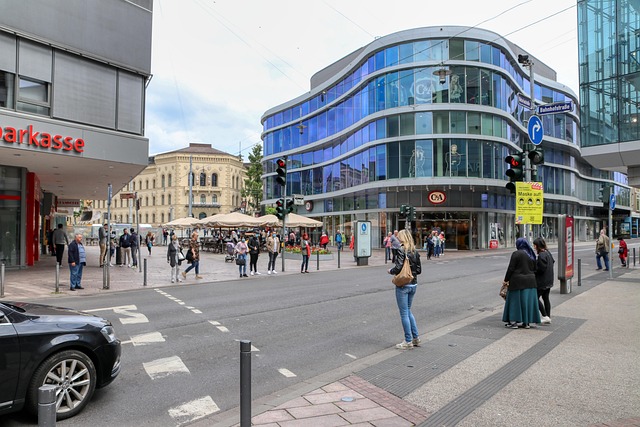Keyword research identifies low-competition yet high-intent keywords for tailored content creation. Engaging content with natural keyword integration and visual elements drives search engine rankings and targeted traffic. Building authority through exceptional content and backlinks enhances domain authority. Intuitive UX design encourages exploration, converting visitors to loyal audience members. Social media integration expands reach through viral sharing, fostering brand awareness. Analyzing data optimizes performance based on user behavior for improved engagement and conversions. Staying agile with algorithm updates ensures ongoing organic traffic growth.
“Unleash the power of organic traffic and drive real audience engagement! This comprehensive guide navigates the strategies essential for building a thriving online presence. From keyword research, the cornerstone of attracting your target market, to crafting compelling content and optimizing user experience, every aspect matters. Discover the art of off-page optimization, social media integration, and data analysis. Learn how to adapt algorithms’ changes and continuously refine your approach. By implementing these tactics, you’ll unlock a steady stream of organic traffic, fostering growth and leaving a lasting impact.”
Keyword Research: Unlocking Target Audience Secrets

Keyword research is a cornerstone in building organic website traffic. It involves digging deep into your target audience’s online behavior and preferences. By using tools like Google Keyword Planner or SEMrush, you can uncover valuable insights about the words and phrases your potential visitors use when searching for information related to your niche. This process helps you identify low-competition, high-intent keywords that can significantly boost your website’s visibility in search engine results.
Understanding your audience’s secrets through keyword research allows you to create content that resonates with them. Tailoring your content around relevant keywords not only increases the chances of ranking higher on search engines but also attracts the right visitors who are genuinely interested in what you have to offer. This strategic approach ensures that your organic traffic is targeted, engaged, and likely to convert, ultimately driving sustainable growth for your website.
On-Page Optimization: Crafting Engaging Content

Crafting engaging content is a cornerstone of on-page optimization, aiming to captivate and retain visitors’ attention while also signaling to search engines that your website offers valuable information. This involves creating high-quality, relevant, and unique content tailored to your target audience’s needs and preferences. Incorporate keywords naturally throughout your text, ensuring readability and relevance remain paramount. Visual elements like images and videos can enhance engagement, but remember to optimize them with descriptive file names and alt tags for better accessibility and SEO.
Regularly updating your website with fresh content is another vital aspect. Fresh content not only keeps your site relevant but also signals to search engines that your site is active and authoritative. Consider diverse content formats such as blog posts, infographics, case studies, or videos to cater to different learning styles and keep visitors engaged. By focusing on quality and relevance, you attract organic traffic from search engine results pages, fostering long-term growth and a loyal audience base.
Off-Page Strategies: Building Authority and Backlinks

Building authority and backlinks are key off-page strategies for driving organic traffic to your website. Backlinks, or inbound links from other websites, signal to search engines that your content is valuable and trustworthy. When high-quality sites link to yours, it boosts your domain authority, which improves your website’s ranking in search results. This, in turn, increases the likelihood of your site appearing in the top results when users search for relevant keywords.
There are several effective ways to earn backlinks. One is by creating exceptional content that naturally attracts links from other sites. Another is to reach out to webmasters and bloggers in your niche, offering collaborations or guest posting opportunities. Building relationships with influencers and industry leaders can also lead to valuable backlink placements. Remember, the quality of backlinks matters more than quantity; focus on earning links from reputable sources within your industry.
User Experience: Designing for Engagement and Retention

Creating a website that attracts and retains visitors is paramount to generating organic traffic. User Experience (UX) design plays a pivotal role in this regard, ensuring your site is more than just visually appealing—it’s intuitive, easy to navigate, and provides value to users. By prioritizing UX, you encourage visitors to explore deeper, interact more, and ultimately stay longer. This increases the likelihood of them returning or sharing your content with others, which is essential for building a loyal audience.
A well-designed UX incorporates engaging elements like high-quality visuals, clear calls-to-action, and informative content that addresses user needs and queries. It also involves optimizing site speed, ensuring mobile responsiveness, and implementing seamless search functionality. These factors collectively contribute to a positive user experience, fostering a connection with your audience and reinforcing your brand’s reputation as a reliable source of information or products—all vital components in the ongoing effort to attract and maintain organic traffic.
Social Media Integration: Leveraging Shares and Likes

Social media integration is a powerful strategy to boost organic traffic to your website. By seamlessly incorporating social sharing buttons and content snippets across your platform, you encourage users to engage with and share your content. Every time someone shares your blog post or article on their favorite social media channel, it expands your reach exponentially. This viral effect can drive new visitors directly to your site, increasing your organic traffic significantly.
Moreover, social media platforms act as a virtual funnel, where likes and follows translate into a loyal audience. By fostering strong social media presences, you build a community that is more likely to engage with your content regularly. Consistent sharing and interaction can lead to increased brand awareness and, ultimately, drive sustained organic traffic over time.
Analyzing Data: Understanding Traffic Patterns and Behaviors

Analyzing data is a crucial step in understanding your website’s performance and attracting more organic traffic. By studying user behavior and traffic patterns, you can gain valuable insights into what works and what doesn’t. Tools like Google Analytics provide detailed information about visitors’ demographics, their paths through your site, and the content they engage with most.
This process involves tracking key metrics such as bounce rates, time on page, and conversion rates to identify areas for improvement. For instance, if you notice a high bounce rate from a specific search query or referral source, it may indicate that the content doesn’t meet user expectations. Armed with this knowledge, you can optimize your site’s content and structure to better align with your audience’s preferences, thereby increasing their likelihood of staying longer and converting into customers.
Continuous Refinement: Adapting to Algorithm Changes

In the ever-evolving digital landscape, one of the key aspects of driving sustainable organic traffic is staying ahead of search engine algorithm updates. These changes are designed to improve user experience and quality of results but can significantly impact website rankings. To stay relevant, it’s crucial for marketers and content creators to embrace a mindset of continuous refinement. This involves regularly reviewing and optimizing content strategies to align with the latest algorithm trends. By staying agile and responsive, websites can adapt to changing search behaviors and preferences, ensuring they remain visible and attractive to their target audience.
Regular updates and adjustments to on-page elements, such as meta tags, headings, and content itself, are essential. Additionally, keeping up with algorithm-focused news and industry insights enables content creators to make informed decisions. This proactive approach not only boosts organic traffic but also fosters a more dynamic and engaging user experience, which is a win-win for both the website and its visitors.
